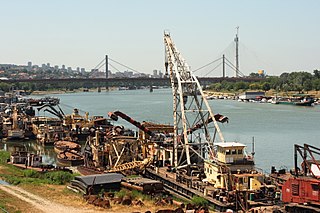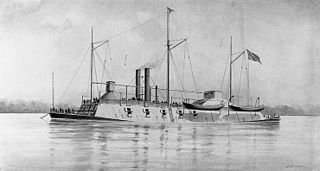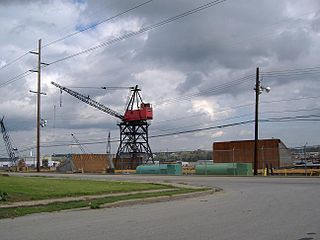
A steamboat is a boat that is propelled primarily by steam power, typically driving propellers or paddlewheels. Steamboats sometimes use the prefix designation SS, S.S. or S/S or PS ; however, these designations are most often used for steamships.

The Cape May–Lewes Ferry is a ferry system in the United States that traverses a 17-mile (27 km) crossing of the Delaware Bay connecting North Cape May, New Jersey with Lewes, Delaware. The ferry constitutes a portion of U.S. Route 9 and is the final crossing of the Delaware River-Delaware Bay waterway before it meets the Atlantic Ocean. It is only one of two direct crossings between Delaware and New Jersey, the other being the Delaware Memorial Bridge

The Eads Bridge is a combined road and railway bridge over the Mississippi River connecting the cities of St. Louis, Missouri, and East St. Louis, Illinois. It is located on the St. Louis riverfront between Laclede's Landing to the north, and the grounds of the Gateway Arch to the south. The bridge is named for its designer and builder, James Buchanan Eads. Work on the bridge began in 1867, and it was completed in 1874. The Eads Bridge was the first bridge across the Mississippi south of the Missouri River. Earlier bridges were located north of the Missouri, where the Mississippi is smaller. None of the earlier bridges survive, which means that the Eads Bridge is also the oldest bridge on the river.

Captain James Buchanan Eads was a world-renowned American civil engineer and inventor, holding more than 50 patents.

The Stan Musial Veterans Memorial Bridge is a bridge across the Mississippi River in the United States between St. Clair County, Illinois, and the city of St. Louis, Missouri. Built between April 19, 2010, and July 2013, the bridge opened on February 9, 2014. The cable-stayed bridge has a main span of 1,500 feet (460 m).

A riverboat is a watercraft designed for inland navigation on lakes, rivers, and artificial waterways. They are generally equipped and outfitted as work boats in one of the carrying trades, for freight or people transport, including luxury units constructed for entertainment enterprises, such as lake or harbour tour boats. As larger water craft, virtually all riverboats are especially designed and constructed, or alternatively, constructed with special-purpose features that optimize them as riverine or lake service craft, for instance, dredgers, survey boats, fisheries management craft, fireboats and law enforcement patrol craft.

USS Benton was an ironclad river gunboat in the United States Navy during the American Civil War. She was named for American senator Thomas Hart Benton. Benton was a former center-wheel catamaran snagboat and was converted by James B. Eads, St. Louis, Missouri, in 1861 and commissioned February 24, 1862 as part of the Army's Western Gunboat Flotilla.

SS Columbia is the last remaining excursion steamship from the turn of the 20th century in existence, the second to last being her running mate and sister ship SS Ste. Claire which burned in 2018. Both were designed by Frank E. Kirby and Louis O. Keil, interior designer. Columbia was listed on the National Register of Historic Places in 1979, and was designated a National Historic Landmark in 1992. As of 2019, the vessel is docked at Silo City in Buffalo, New York while work is being done to rehabilitate it. However as of February 2024 the restoration group's website was offline and archived images showed no updates since 2021.

USS Albatross was a screw steamer rigged as a three-masted schooner acquired by the Union Navy during the beginning of the American Civil War. She was outfitted as a gunboat with heavy guns and used in the Union blockade of the waterways of the Confederate States of America.

The Alexander Arbuthnot is the last paddle steamer built as a working boat during the riverboat trade era on the Murray River, Australia.

Jeffboat was a shipyard in Jeffersonville, Indiana founded by James Howard in 1834, a builder of steamboats. The company was owned by the Howard family until it was sold leading up to World War II. Following the war, it became known as the Jeffersonville Boat and Machine Company and later changed its name to Jeffboat, the more commonly used short form of its name. The company was the largest inland shipbuilder in the United States and the second-largest builder of barges before it closed in 2018.

President Casino Laclede's Landing was a stationary riverboat casino in Saint Louis, Missouri owned by Pinnacle Entertainment.

The SS Christopher Columbus was an American excursion liner on the Great Lakes, in service between 1893 and 1933. She was the only whaleback ship ever built for passenger service. The ship was designed by Alexander McDougall, the developer and promoter of the whaleback design.

President is a steamboat that currently lies dismantled in Effingham, Illinois, United States. Originally named Cincinnati, it was built in 1924 and is the only remaining "Western Rivers" style sidewheel river excursion steamboat in the United States. She was listed on the National Register of Historic Places and declared a National Historic Landmark in 1989, although these designations were revoked in 2011. Her home ports have been Cincinnati, Ohio; New Orleans, Louisiana; Vicksburg, Mississippi; St. Louis, Missouri; and Davenport, Iowa.
USS Ivy was a steamer acquired by the Union Navy during the American Civil War.

SS Ste. Claire is a steamer located in Detroit, Michigan. Built in 1910, she was one of the last propeller-driven excursion steamers to be operated on the Great Lakes. She was declared a US National Historic Landmark in 1992. In 2018, a devastating fire destroyed the upper decks, leaving only the steel structure. The ship was delisted as a National Historic Landmark and from the National Register of Historic Places in 2023.

M/V Mississippi is a United States Army Corps of Engineers (USACE) towboat operating on the Mississippi River. It is the largest diesel towboat on the river.
John Edward Connelly was an American entrepreneur. He founded the Gateway Clipper Fleet in Pittsburgh, Pennsylvania, pioneered riverboat casino gambling along the Mississippi River via his President Casinos empire and founded a fleet of ships operating out of Chelsea Piers in New York City. He was a member of the Democratic Party.
Streckfus Steamers was a company started in 1910 by John Streckfus Sr. (1856–1925) born in Edgington, Illinois. He started a steam packet business in the 1880s, but transitioned his fleet to the river excursion business around the turn of the century. In 1907, he incorporated Streckfus Steamers to raise capital and expand his riverboat excursion business. A few years later, the firm acquired the Diamond Jo Line, a steamboat packet company.
Verne Swain refers to three steamboats built by the Swain Shipyard of Stillwater, Minnesota. Swain built the first one in 1886, the second one in 1904, and the last one in 1913.


















